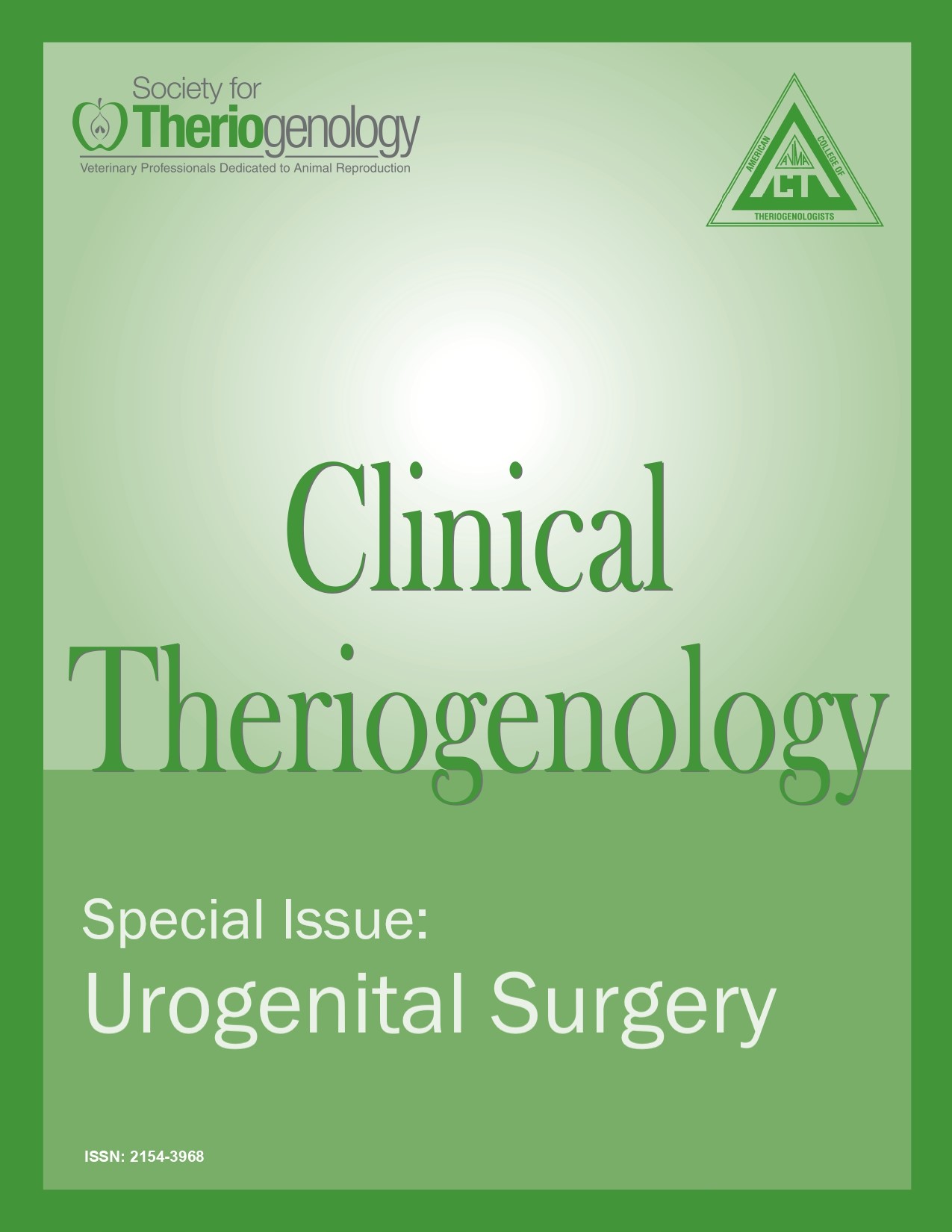Laparoscopic-assisted cryptorchidectomy in South American camelids and Nigerian dwarf goats
Abstract
Cryptorchidism is a common sexual development disorder in males with a potential hereditary origin in goats and camelids. Cryptorchid animals should be removed from breeding and castrated to eliminate male behavior. The objective of this paper is to describe the presentation and procedure of laparoscopic-assisted cryptorchidectomy in goats and South American camelids. Records of 18 Nigerian dwarf goats and 16 camelid cases that were presented to the WSU Theriogenology Services were included. Goats ranged in age from 2 months to 1 year and camelids (14 alpacas and 2 llamas) were between 15 months and 5 years of age. In goats, 15/18 (83%) were unilateral cryptorchids while 3/18 (17%) were bilateral. The right testicle was retained abdominally in 73.3% (11/15) of the unilaterally cryptorchid goats. All the camelids presented as unilateral cryptorchids with abdominally retained testis. The left testis was retained in 9/16 (56.25%) cases while the right was retained in 7/17 (43.75%). Laparoscopic-assisted cryptorchidectomy was performed under general anesthesia in all cases. The remaining scrotal testicle was castrated using a closed technique. There were no surgical complications. Ability to confirm the presence of cryptorchid testis without laparotomy, smaller incision, lesser intraabdominal manipulation, and lesser-no post/surgical complications advocate the use of this technique for cryptorchidectomy.
Downloads
References
2. Sumar J: Studies on reproductive rathology in alpacas. MS thesis, Department of Obstetrics and Gynaecology, College of Veterinary Medicine, Swedish, University of Agricultural Sciences, Uppsala, 1983.
3. Drew ML, Meyers-Wallen VN, Acland GM, et al: Presumptive Sry-negative XX sex reversal in a llama with multiple congenital anomalies. J Am Vet Med Assoc 1999;215:1134–1139.
4. Khan LA, Rghuwanshi DS, Sirsat PR, et al: Incidence of cryptorchidism in goats. Ind J F Vet 2008;3:74.
5. Oguejiofor CF, Ochiogu IS, Okoro OL, et al: Consequences of unilateral cryptorchidism on semen and sperm characteristics in West African Dwarf goats. Asian Pac J Reprod 2018;7:172–177. doi: 10.4103/2305-0500.237055
6. Igbokwe IC, Ezeasor DN, Onwuka OS: Comparative study of the morphology of the testes and excurrent ducts system in the unilateral cryptorchid West African dwarf goats. Niger Vet J 2007;28:40–47. doi: 10.4314/nvj.v28i3.3565
7. Igbokwe IO, Abba Y, Geidam SU, et al: Sperm output from unilateral cryptorchid Sahel goats. Comp Clin Path 2014;23:819–822. doi: 10.1007/s00580-013-1695-7
8. Tibary A, Pearson LK, Anouassi A: Applied andrology in camelids. In: Chenoweth P, Lorton S: editors. Animal Andrology: Theories and Applications. Wallingford; CABI: 2014. p. 418–449.
9. Fite C, Tibary A, Reeves J, et al: Testosterone response in male alpacas (Lama pacos) following hCG administration and correlation with testicular weight. Theriogenology 2005;64:782.
10. Tibary A, Campbell A, Rodriguez J, et al: Urogenital surgery in camelids. Clin Theriogenol 2020;12:271–291.
11. El-Zawam A, Tibary A, Patino C: Basal levels and hCG responses of serum testosterone and estrogen in male alpacas. Front Vet Sci 2020;7:595856. doi: 10.3389/fvets.2020.595856
12. Rietschel W: Kryptorchismus beim vicunja (Lama vicugna). Tierarztliche Praxis 1990;18:459–461.
13. Perkins NR, Frazer GS, Hull BL: Endocrine diagnosis of cryptorchidism in a llama. Aust Vet J 1996;74:275–277. doi: 10.1111/j.1751-0813.1996.tb13773.x
14. Haig FM, Baird AN, Hawkins JF, et al: Caudal paramedian approach to cryptorchidectomy in 29 small ruminants (2011–2019). Vet Surg 2020;50:170–176. doi: 10.1111/vsu.13546
15. Parker JE, Semevolos SA: Use of a parainguinal approach for cryptorchidectomy in alpacas. J Am Vet Med Assoc 2002;220:1835–1836. doi: 10.2460/javma.2002.220.1835
16. Garcia Pereira FL, Allen A, Anouassi A, et al: Parainguinal cryptorchidectomy under general anaesthesia in a Bactrian camel (Camelus bactrianus). J Camel Pract Res 2004;11:103–107.
17. Ciccarelli M, Tibary A, Campbell AJ, et al: Effect of age and castration on serum anti-Müllerian hormone concentration in male alpacas. Theriogenology 2018;105:174–177. doi: 10.1016/j.theriogenology.2017.09.032

This work is licensed under a Creative Commons Attribution-NonCommercial 4.0 International License.
Authors retain copyright of their work, with first publication rights granted to Clinical Theriogenology. Read more about copyright and licensing here.





